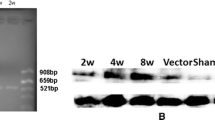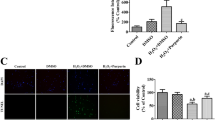Abstract
A replication defective adenoviral vector containing the E. coli lacZ gene (AdCMVnLacZ) was directly injected into right hippocampus and lateral ventricle immediately after 5 min of transient global ischemia in gerbils. The relations between the lacZ gene expression and DNA fragmentation or heat shock protein 72 (HSP72) immunoreactivity were examined up to 21 days post ischemia. The lacZ gene was transiently expressed at 1 day in the hippocampus except around the CA1 region, while a large number of the periventricular cells strongly expressed the lacZ gene from 8 h to 7 days. In CA1 layer terminal deoxynucleotidyl dUTP nick end labeling (TUNEL) positive cells, which were present only adjacent to the needle track at 8 h to 1 day, became more extensive in the whole CA1 layer at 3 to 7 days. TUNEL-positive cells were also detected around the DG at 1 day, around the needle track at 8 h to 3 days, and in the choroid plexus cells at 7 days HSP72 staining was detected in the subiculum at 1 to 3 days, the dentate granule cells at 8 h to 1 day, and in the CA3 or CA4 pyramidal cells at 1 to 3 days. Some lacZ expressing cells were double-positive with HSP72 in DG, while the majority of those were distinguished from the TUNEL-positive cells. Pyramidal neurons were almost completely lost in the CA1 sector at 7days after the ischemia. The present study demonstrates the successful LacZ gene transfer into the hippocampus and ventricle of postischemic gerbil brain except in the vulnerable CA1 layer by adenoviral vector injection. However adenovirus-mediated gene transfer may induce indirect apoptotic cell death in the DG and ventricle, in addition to direct traumatic injury around the needle track.
Similar content being viewed by others
REFERENCES
Abe, K., Aoki, M., Kawagoe, J., Yoshida, T., Hattori, A., Kogure, K. and Itoyama, Y. (1995). Ischemic delayed neuronal death: A mitochondrial hypothesis. Stroke 26:1478–1489.
Abe, K., Setoguchi, Y., Hayashi, T. and Itoyama, Y. (1997a). In vivo adenovirus-mediated gene transfer and the expression in ischemic and reperfused rat brain. Brain Res. 763:191–201.
Abe, K., Setoguchi, Y., Hayashi, T. and Itoyama, Y. (1997b). Dissociative expression of adenoviral-mediated E.coli LacZ gene between ischemic and reperfused rat brains. Neurosci. Lett. 226:53–56.
Abe, K., Tanzi, R.E. and Kogure, K. (1991). Induction of HSP70 mRNA after transient ischemia in gerbil brain. Neurosci. Lett. 125:166–168.
Akli, S., Caillaud, C., Vigne, E., Stratford-Perricaudet, L.D., Poenaru, L., Perricaudet, M., Kahn, A. and Peschanski, M.R. (1993). Transfer of a foreign gene into the brain using adenovirus vectors. Nature Genet. 3:224–228.
Bajocchi, G., Feldman, S.H., Crystal, R.G. and Mastrangeli, A. (1993). Direct in vivo gene transfer to ependymal cells in the central nervous system using recombinant adenovirus vectors. Nature Genet. 3:229–234.
Betz, A.L., Yang, G.-Y. and Davidson, B.L. (1995). Attenuation of stroke size in rats using an adenoviral vector to induce overexpression of interleukin-1 receptor antagonist in brain. J. Cereb. Blood Flow Metab. 15:547–551.
Bilang-Bleuel, A., Revah, F., Colin, P., Locquet, I., Robert, J.-J., Mallet, J. and Horellou, P. (1997). Intrastriatal injection of an adenoviral vector expressing glial-cell-line-derived neurotrophic factor prevents dopaminergic neuron degeneration and behavioral impairment in a rat model of Parkinson disease. Proc. Natl. Acad. Sci. U.S.A. 94:8818–8823.
Breakefield, X.O. (1993). Gene delivery into the brain using virus vectors. Nature Genet. 3:187–189.
Byrnes, A.P., Rusby, J.E., Wood, M.J.A. and Charlton, H.M. (1995). Adenovirus gene transfer causes inflammation in the brain. Neuroscience 66:1015–1024.
Charriaut-Marlangue, C., Margaill, I., Represa, A., Popovici, T., Plotkine, M. and Ben-Ari, Y. (1996). Apoptosis and necrosis after reversible focal ischemia: an in situ DNA fragmentation analysis. J. Cereb. Blood Flow Metab. 16:186–194.
Chen, J., Graham, S.H., Nakayama, M., Zhu, R.L., Jin, K., Stetler, R.A. and Simon, R.P. (1997). Apoptosis repressor genes bcl-2 and bcl-x-long are expressed in the rat brain following global ischemia. J. Cereb. Blood Flow Metab. 17:2–10.
Davidson, B.L., Allen, E.D., Kozarsky, K.F., Wilson, J.M. and Roessler, B.J. (1993). A model system for in vivo gene transfer into the central nervous system using an adenoviral vector. Nature Genet. 3:219–223.
Deshpande, J., Bergstedt, K., Linden, T., Kalimo, H. and Wieloch, T. (1992). Ultrastructural changes in the hippocampal CA1 region following transient cerebral ischemia: evidence against programmed cell death. Exp. Brain Res. 88:91–105.
Gething, M.-J. and Sambrook, J. (1992). Protein folding in the cell. Nature 355:33–45.
Heistad, D.D. and Faraci, F.M. (1996). Gene therapy for cerebral vascular disease. Stroke 27:1688–1693.
Honkaniemi, J., Massa, S.M., Breckinridge, M. and Sharp, F.R. (1996). Global ischemia induces apoptosis-associated genes in hippocampus. Mol. Brain Res. 42:79–88.
Iwai, T., Hara, A., Niwa, M., Nozaki, M., Uematu, T., Sakai, N. and Yamada, H. (1995). Temporal profile of nuclear DNA fragmentation in situ in gerbil hippocampus following transient forebrain ischemia. Brain Res. 671:305–308.
Kawagoe, J., Abe, K., Sato, S., Nagano, I., Nakamura, S. and Kogure, K. (1992). Distributions of heat shock protein-70 mRNAs and heat shock cognate protein-70 mRNAs after transient global ischemia in gerbil brain. J. Cereb. Blood Flow Metab. 12:794–801.
Kihara, S., Shiraishi, T., Nakagawa, S., Toda, K. and Tabuchi, K. (1994). Visualization of DNA double strand breaks in the gerbil hippocampal CA1 following transient ischemia. Neurosci. Lett. 175:133–136.
Kirino, T. (1982). Delayed neuronal death in the gerbil hippocampus following ischemia. Brain Res. 239:57–69.
La Salle, G.L.G., Robert, J.J., Berrard, S., Ridoux, V., Stratford-Perricaudet, L.D., Perricaudet, M. and Mallet, J. (1993). An adenovirus vector for gene transfer into neurons and glia in the brain. Science 259:988–990.
Lee, T.-H., Abe, K., Aoki, M., Nakamura, M., Kogure, K. and Itoyama, Y. (1994). The protective effect of L-threo-3,4-dihydroxyphenylserine on ischemic hippocampal neuronal death in gerbils. Stroke 25:1425–1432.
Li, Y., Chopp, M., Jiang, N., Yao, F. and Zaloga, C. (1995). Temporal profile of in situ DNA fragmentation after transient middle cerebral artery occlusion in the rat. J. Cereb. Blood Flow Metab. 15:389–397.
MacManus, J.P., Buchan, A.M., Hill, I.E., Rasquinha, I. and Preston, E. (1993). Global ischemia can cause DNA fragmentation indicative of apoptosis in rat brain. Neurosci. Lett. 164:89–92.
MacManus, J.P., Hill, I.E., Preston, E., Rasquinha, I., Walker, T. and Buchan, A.M. (1995). Differences in DNA fragmentation following transient cerebral or decapitation ischemia in rats. J. Cereb. Blood Flow Metab. 15:728–737.
Newman, K.D., Dunn, P.F., Owens, J.W., Schulick, A.H., Virmani, R., Sukhova, G., Libby, P. and Dichek, D.A. (1995). Adenovirus-mediated gene transfer into normal rabbit arteries results in prolonged vascular cell activation, inflammation, and neointimal hyperplasia. J. Clin. Invest. 96:2955–2965.
Nitatori, T., Sato, N., Waguri, S., Karasawa, Y., Araki, H., Shibanai, K., Kominami, E. and Uchiyama, Y. (1995). Delayed neuronal death in the CA1 pyramidal cell layer of the gerbil hippocampus following transient ischemia is apoptosis. J. Neurosci. 15:1001–1011.
Nowak, T.S. (1991). Localization of 70 kDa stress protein mRNA induction in gerbil brain after ischemia. J. Cereb. Blood Flow Metab. 11:432–439.
Petito, C.K., Feldmann, E., Pulsinelli, W.A. and Plum, F. (1987). Delayed hippocampal damage in humans following cardiorespiratory arrest. Neurology 37:1281–1286.
Petito, C.K., Torres-Munoz, J., Roberts, B., Olarte, J.-P., Nowak, T.S. and Pulsinelli, W.A. (1997). DNA fragmentation follows delayed neuronal death in CA1 neurons exposed to transient global ischemia in the rat. J. Cereb. Blood Flow Metab. 17:967–976.
Pulsinelli, W.A., Brierley, L.B. and Plum, F.C. (1982). Temporal profile of neuronal damage in a model of transient ischemia. Ann. Neurol. 11:491–498.
Rosenfeld, M.A., Siegfried, W., Yoshimura, K., Yoneyama, K., Fukayama, M., Stier, L.E. et al. (1991). Adenovirus-mediated transfer of a recombinant alphal-antitrypsin gene to the lung epithelium in vivo. Science 252:431–434.
Sei, Y., Von Lubitz, D.K.J.E., Basile, A.S., Borner, M.M., Lin, R.C.-S., Skolnick, P. and Fossom, L.H. (1994). Internucleosomal DNA fragmentation in gerbil hippocampus following forebrain ischemia. Neurosci. Lett. 171:179–182.
Setoguchi, Y., Danel, C. and Crystal, R.G. (1994). Stimulation of erythropoiesis by in vivo gene therapy: Physiologic consequences of transfer of the human erythropoietin gene to experimental animals using an adenovirus vector. Blood 84:2946–2953.
States, B.A., Honkaniemi, J., Weinstein, P.R. and Sharp, F.R. (1996). DNA fragmentation and HSP70 protein induction in hippocampus and cortex occurs in separate neurons following permanent middle cerebral artery occlusions. J. Cereb. Blood Flow Metab. 16:1165–1175.
Thilmann, R., Xie, Y., Kleihues, P. and Kiessling, M. (1986). Persistent inhibition of protein synthesis precedes delayed neuronal death in postischemic gerbil hippocampus. Acta Neuropathol. (Berl.) 71:88–93.
Vass, K., Welch, W.J. and Nowak, T.S. (1988). Localization of 70-kDa stress protein induction in gerbil brain after ischemia. Acta Neuropathol. (Berl.) 77:128–135.
Verma, I.M. and Somia, N. (1997). Gene therapy-promises, problems and prospects. Nature 389:239–242.
Yang, G.-Y., Zhao, Y.-J., Davidson, B.L. and Betz, A.L. (1997). Overexpression of interleukin-1 receptor antagonist in the mouse brain reduces ischemic brain injury. Brain Res. 751:181–188.
Yoshidomi, M., Hayashi, T., Abe, K. and Kogure, K. (1989). Effect of a new calcium channel blocker, KB-2796, on protein synthesis of the CA1 pyramidal cell and delayed neuronal death following transient forebrain ischemia. J. Neurochem. 53:137–142.
Author information
Authors and Affiliations
Rights and permissions
About this article
Cite this article
Kitagawa, H., Setoguchi, Y., Fukuchi, Y. et al. DNA Fragmentation and HSP72 Gene Expression by Adenovirus-Mediated Gene Transfer in Postischemic Gerbil Hippocampus and Ventricle. Metab Brain Dis 13, 211–223 (1998). https://doi.org/10.1023/A:1023224025407
Issue Date:
DOI: https://doi.org/10.1023/A:1023224025407




